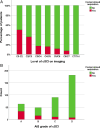Epidemiology of Traumatic Cervical Spinal Cord Injury in Southeast Norway
- PMID: 40630650
- PMCID: PMC12235120
- DOI: 10.1089/neur.2025.0013
Epidemiology of Traumatic Cervical Spinal Cord Injury in Southeast Norway
Abstract
A traumatic cervical spinal cord injury (cSCI) is a severe consequence of trauma to the cervical spine with high mortality and morbidity rates. Epidemiological studies of traumatic cSCIs are necessary for planning preventive measures and health care resource allocation. This is a retrospective database study of 387 consecutive patients with traumatic cSCI admitted to hospitals in Southeast Norway between 2015 and 2022. The estimated incidence of traumatic cSCI was 1.6 per 100,000 per year. The incidence rates adjusted for standard European and global populations were 1.7 and 1.1 per 100,000 per year, respectively. The median patient age was 64 years, 75% were males, 40% had severe comorbidities, 65% of injuries were caused by falls, 25% were ethanol influenced, 44% had multiple traumas, and 96% were admitted to the Neurotrauma Center (NTC). In patients with C0-C2 injury, an odontoid fracture with dislocation of the odontoid fragment was most frequent. The most frequent subaxial injuries were, according to the AO Spine subaxial cervical spine injury classification system, minor nonstructural injuries (type A0) and translational injuries (type C). Eleven percent of patients were diagnosed with cSCIs at C0-C2, and 89% of cSCIs were subaxial. According to the American Spinal Injury Association (ASIA) Impairment Scale (AIS), 17% of cSCIs were classified as A, 12% B, 24% C, and 47% D. Forty-three percent of patients were classified as central cord syndrome, which was significantly associated with subaxial injuries and preinjury degenerative cervical spinal stenosis. Compromised respiration due to the cSCI itself was diagnosed in 17% of patients and was predominant in patients with complete cSCIs (AIS A or B) and high cervical injuries. These data will be helpful in planning the capacity of NTCs in the future. Interventions to prevent falls in elderly individuals and to increase awareness of ethanol as a risk factor for severe cSCIs are needed.
Keywords: Norway; comorbidity; epidemiology; injury prevention; spinal cord injuries; trauma mechanism.
© The Author(s) 2025. Published by Mary Ann Liebert, Inc.
Figures





Similar articles
-
A systematic review and meta-analysis of the global epidemiology of pediatric traumatic spinal cord injuries.Eur J Pediatr. 2023 Dec;182(12):5245-5257. doi: 10.1007/s00431-023-05185-9. Epub 2023 Oct 9. Eur J Pediatr. 2023. PMID: 37814152
-
PECARN prediction rule for cervical spine imaging of children presenting to the emergency department with blunt trauma: a multicentre prospective observational study.Lancet Child Adolesc Health. 2024 Jul;8(7):482-490. doi: 10.1016/S2352-4642(24)00104-4. Epub 2024 Jun 4. Lancet Child Adolesc Health. 2024. PMID: 38843852 Free PMC article.
-
Functional outcomes in unstable complete subaxial cervical spinal injuries with respiratory paralysis and/or hemodynamic instability.Clin Neurol Neurosurg. 2024 Oct;245:108494. doi: 10.1016/j.clineuro.2024.108494. Epub 2024 Aug 3. Clin Neurol Neurosurg. 2024. PMID: 39151221
-
Systemic pharmacological treatments for chronic plaque psoriasis: a network meta-analysis.Cochrane Database Syst Rev. 2021 Apr 19;4(4):CD011535. doi: 10.1002/14651858.CD011535.pub4. Cochrane Database Syst Rev. 2021. Update in: Cochrane Database Syst Rev. 2022 May 23;5:CD011535. doi: 10.1002/14651858.CD011535.pub5. PMID: 33871055 Free PMC article. Updated.
-
What Is the Epidemiology of Cervical and Thoracic Spine Fractures?Clin Orthop Relat Res. 2024 Dec 1;482(12):2222-2235. doi: 10.1097/CORR.0000000000003189. Epub 2024 Jul 16. Clin Orthop Relat Res. 2024. PMID: 39017523
References
LinkOut - more resources
Full Text Sources
Miscellaneous
